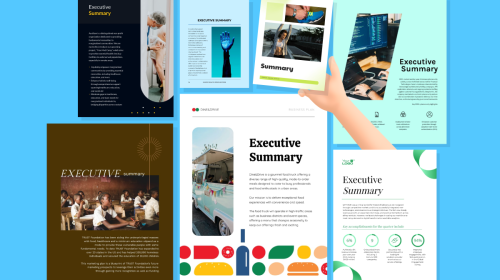
10 Best RFP Software for 2025: In-Depth Review + Comparison Chart


Whether you’re running a small business or a large enterprise, you’ll likely deal with RFPs at some point.
You’d either have to send them out to find the right vendors or respond to them to win new clients.
But as your business grows, so does the complexity of handling RFPs.
Managing RFPs manually not only takes a lot of time but can also be riddled with misinformation.
That’s why more businesses are turning to RFP software to streamline their workflow.
These tools don’t just save time—they help teams centralize knowledge, improve collaboration, automate task and create high-quality proposals with ease.
And it’s easy to see why they’re gaining traction. In fact, 65% of teams now use specialized RFP software, up from 48% just last year.
Businesses are investing in these solutions because they recognize the competitive edge they provide.
Now, let’s take a look at some options!
I’ve reviewed the top 10 RFP software solutions for 2025 and analyzed their key features, limitations, pricing structures and best use cases. Plus, I’ve shared ideas on how you can add Visme to your RFP process and make it even more effective.
*Disclaimer: The comparisons and competitor ratings presented in this article are based on features available as of October 06, 2025. We conduct thorough research and draw on both first-hand experience and reputable sources to provide reliable insights. However, as tools and technologies evolve, we recommend readers verify details and consider additional research to ensure the information meets their specific needs.
An RFP (Request for Proposal) software is a digital tool that helps organizations simplify and speed up the process of creating, managing and responding to RFPs.
It makes the whole process more organized and less time-consuming by providing features like:
RFP software falls into two categories:
The first category is one for issuers (buyers) to create professional RFPs, distribute them to vendors, receive and evaluate responses,
The second category is for the RFP response software that helps (service providers or vendors) to manage incoming RFP opportunities, craft competitive proposals and track progress.
Using the proper tools is important because as the 2024 State of Strategic Response Management Report shares,
"Ad hoc responses and scattered content no longer cut it. Leading organizations are prioritizing Strategic Response Management (SRM) — the people, practices, and technology that unlock organizational knowledge for profitable growth — to gain an outsized competitive advantage."
As a vendor or buyer, here are several reasons why you need RFP software to take care of the RFP process in your organization:
When selecting the best RFP software for your needs, consider the following aspects to improve your efficiency.
A robust content library is essential for your RFP response team.
If you’re in procurement, look for tools that have libraries with previous RFP samples.
As a vendor, you need software that stores, categorizes and quickly retrieves previously approved responses.
The best RFP tools include intelligent search functionality and AI systems that can suggest relevant content based on the questions in your current RFP.
This dramatically reduces the time spent crafting answers to common questions and ensures consistency across all your proposals.
Modern RFP software leverages AI to support the response process.
As Arvind Sinha notes on Winning the Business,
“Time is money, and AI shortens the time. If the AI feedback helps me identify my core areas to work on with precision, then—instead of something taking me five weeks—I can do the same thing in three. I’m cutting down on 20-40% of my time and, at the same time, improving the quality of my responses immensely.”
Look for tools that offer auto-fill capabilities, question-answer matching and AI-powered content suggestions. The most advanced solutions can even analyze an RFP document, extract questions and automatically populate responses from your content library, leaving your team to focus only on customizing and refining the content.
RFP and RFP response creation requires input from multiple stakeholders across different departments. Effective RFP software should facilitate seamless collaboration with features such as:
These collaboration features eliminate confusion, prevent version control issues and ensure all team members can contribute efficiently to the proposal process.
Data-driven insights can significantly improve your RFP win rates and vendor procurement over time. Look for software that provides comprehensive analytics on:
These insights help identify bottlenecks in your process, understand which responses resonate with evaluators, and continuously optimize your approach to RFPs.
When handling sensitive business information and client data, security is paramount. Your RFP software should adhere to industry security standards and compliance requirements such as:
Additionally, the platform should help maintain compliance with the specific requirements outlined in each RFP, such as formatting guidelines, word count limitations, and mandatory response elements.
The second point is super important because, as Juliet Fletcher, a proposal writing expert, shared during a webinar with Sirena Moore-Thomas,
"At the very bottom is the most important thing when responding to an RFP—you want to comply with the requirements, and that includes the instructions for the proposal."
The best RFP software doesn't operate in isolation. Look for solutions that integrate with your existing tech stack, including:
These integrations create a seamless workflow from opportunity identification through proposal submission and follow-up.
Even the most feature-rich software will fail if your team finds it difficult to use. Prioritize solutions with intuitive interfaces, customizable dashboards, and comprehensive training resources. The learning curve should be minimal, allowing your team to adopt the new system and realize its benefits quickly.
Check out this article, 24 industry-specific RFP examples, to gain insights into various formats, requirements and best practices.
| RFP Software | Key Features | Pricing | Best For | G2 Rating | Capterra Rating |
| Bonfire | Centralized procurement platform, Digital scorecards for vendor evaluation, Messaging and collaboration tools, Public RFP visibility, Data-driven supplier ranking. | Upon request | Government, Public Sector, Large Organizations | 4.5 (10+ reviews) | 4.5(10+ reviews) |
| Vendorful | Real-time collaboration, Blind RFPs to minimize bias, Automated proposal aggregation, Drag-and-drop RFP builder, Excel-compatible | Upon request | Businesses of All Sizes | No Reviews | No Reviews |
| Proposify | Drag-and-drop template editor, Content library, Permission settings, Reporting and analytics, E-signatures | Starts at $19/month | Small Businesses and Mid-Market | 4.6 (1200+ reviews) | 4.4 (300 reviews) |
| Responsive | Unlimited content library, Workflow customization, integrations with CRM, cloud storage, MS Office, and Comprehensive security standards. | Only upon request | Enterprise | 4.5 (1200+ reviews) | 4.6 (160+ reviews) |
| Proposable | Proposal template gallery, billing features, Integration with CRM systems, E-signatures, Collaboration and approval controls. | Starts with $19/month | Small Businesses | 4.2 (70+ reviews) | 4.4 (110+ reviews) |
| 1Up | Response building in Word and Excel, Multiple language capabilities, Workflow management, Slack, Teams and Google Chat communication integration. | Starts at $250/month | Businesses of All Sizes | 4.9 (20+ reviews) | N/A |
| Loopio | AI auto-fill, Project tracking, Smart content library, go/no-go qualifier, Team collaboration with user roles. | Upon request | Businesses of All Sizes | 4.7 (730+ reviews) | 4.6 (70+ reviews) |
| Upland Qvidian | AI Assistant, Automated answering, customizable content library, professional style templates, drag and drop report builder. | Upon request | Mid-Market and Enterprise | 4.3 (150+ reviews) | N/A |
| Sequesto | Repository of company documentation, Project tracking dashboard, Collaboration features, Reference mapping for creating product lists, translation to several languages. | Upon request | Businesses of All Sizes | 4.9 (10 reviews) | N/A |
| AutoRFP.ai | Chrome browser extension, Multilingual functionalities, AI response agent, Slack assistant for team communication, Tracking calendar. | Starts with $349/month | Mid-Market and Enterprise | 4.9 (50+ reviews) | 5.0 (1 review) |
| Qwilr | Web-based interactive proposals with brand controls, Integrated payments & e-sign in one session, CRM integrations , Interactive pricing tables & quotes, Enterprise security & SSO. | Business $35/user/month; Enterprise $59/user/month | Vendors of all sizes needing polished, interactive, trackable proposals connected to CRM and revenue workflows. | 4.6 (800+ reviews) | 4.6 (380+ reviews) |
Let’s look at ten of the best and trusted RFP software available online today.
We’ve arranged these tools into two main categories:
You’ll find several types of RFP software in the list, ranging from free tools for small businesses to more robust platforms for enterprise companies. You’ll discover options that serve both buyers and vendors, as well as those tailored for one group.
What’s exciting is that most of the tools I reviewed use AI to help respond to RFPs faster and more effectively. These tools are the top results in G2 and Capterra. So, it´s not surprising that a survey by Loopio found that 68% of teams now use AI, double last year’s number, and 70% use it at least weekly.
For those who prefer a more traditional approach, we’ve also included some RFP software options that don’t use AI, just in case you want to try those out as well.
Bonfire is a cloud-based RFP software that helps procurement teams run and manage open and transparent RFX events.
I couldn't grab a free trial, so I checked out their demo video to see what the tool is all about—and honestly, it's a game-changer for procurement teams.

You can create a new project from scratch or pull from existing templates and past projects. If you need inspiration, Bonfire gives you access to 500+ public projects from agencies in its network, making it easy to learn from best-in-class RFPs.
Setting up a project is straightforward—just enter your project name and type (Bonfire supports RFPs, RFQs, RFSQs, ITBs, RFBs, RFIs, RFTs and more), define your project visibility, description, open/close dates, question due date, and evaluation timeline, and with one click, you’re ready to go.
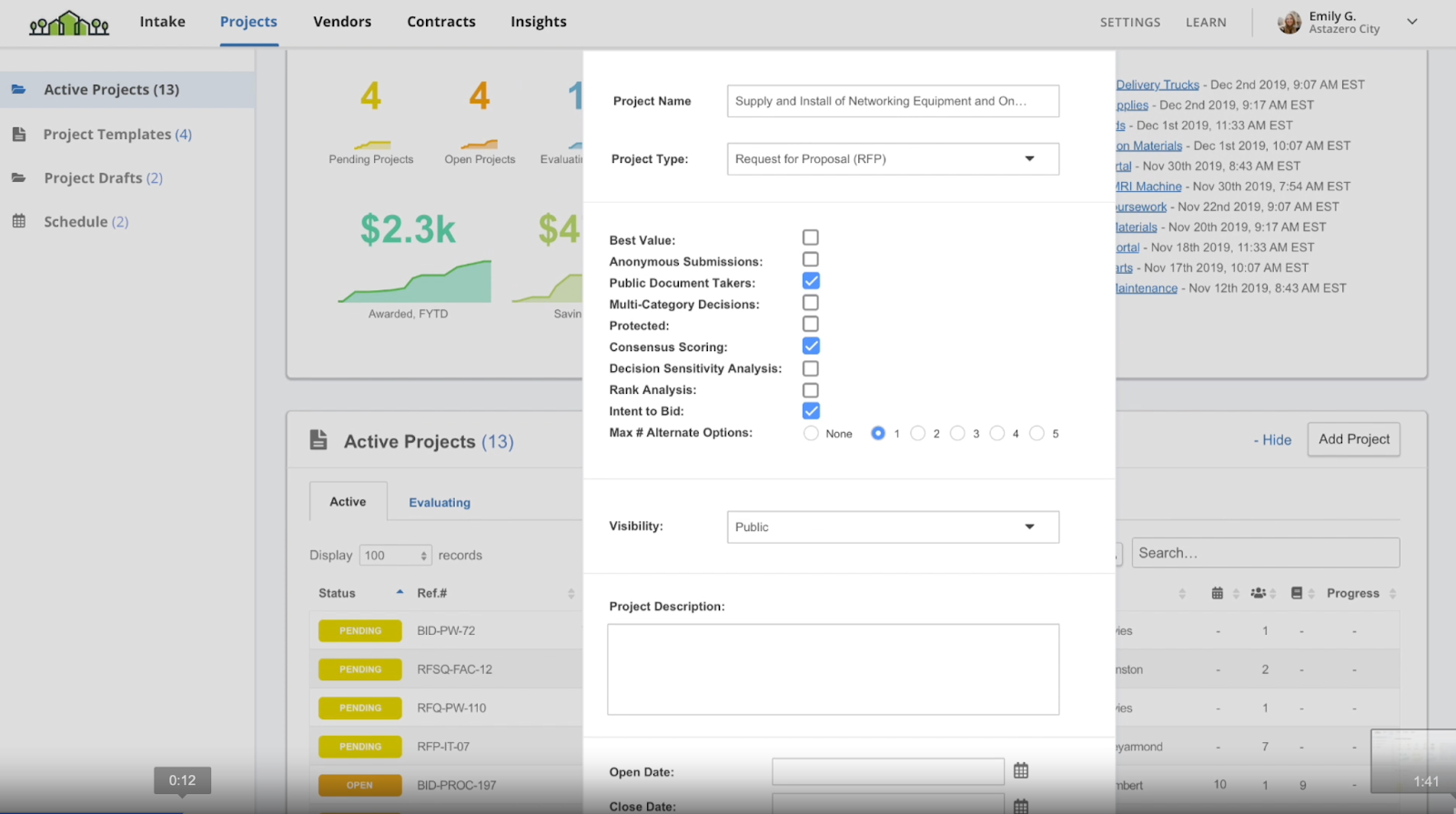
Bonfire makes collaboration seamless with a built-in messaging tool that keeps teams connected without endless email chains. It also gives procurement teams and buyers the ability to filter supplier data, rank prices, sort items into baskets and run what-if analyzes to make smarter vendor selections.
Decision-making criteria can be customized and weighted, then organized into digital scorecards, so evaluators only see the information relevant to them.
Another interesting part is that over 500 public sector organizations use Bonfire to post opportunities and evaluate RFPs. The software is also open to vendors and suppliers. They can search for opportunities, view project details and documents, and submit bids.
And the best part? It’s 100% free (and oh so easy). Unlike email or time-consuming mail-in submissions, vendors receive email confirmation when their bid is received, along with real-time notifications on status changes, addendums and final award decisions.
If you're looking for an intuitive, efficient way to manage RFPs, Bonfire might be worth exploring. While I couldn’t test it firsthand, the demo made it clear that it’s built to simplify procurement from start to finish.
Bonfire Premium Vendor costs $499 per year. Pricing for other solutions. is available upon request.
Here's a testimonial from one of Bonfire's happy customers
“This has been a win-win-win: across every segment of our vast territory, rural and urban alike, the number of submissions has gone up. Our member boards now have the ability to monitor and plan for every stage of the procurement process. And our buyers are focused on high value work.”- Lori Letourneau, Directrice Du Centre D’Excellence en Approvisionnment Francoachat (CEA FRANCOachat)
Vendorful is a powerful e-sourcing and vendor management platform built for businesses, buying committees, procurement teams, corporations, government and the public sector.
Just like many of the other tools out there, I didn't have the chance to test this one directly since there’s no free trial or plan available. Instead, I had to rely on demo videos and resources from their website to see what it offered.
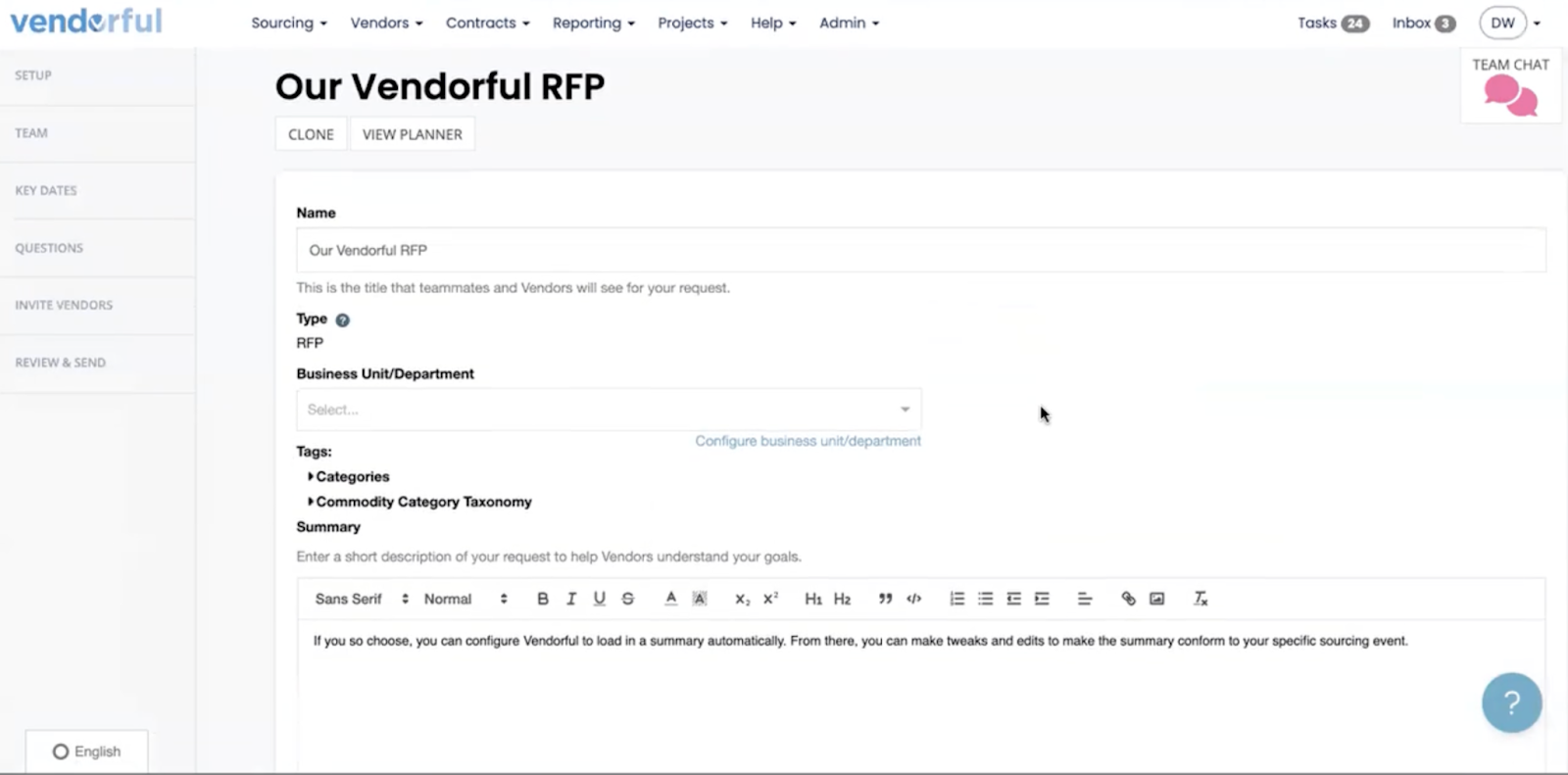
To kick off the process of creating an RFX, you start by clicking on "Create a New Request." From there, just enter your Request Name and choose the type of request—whether it's an RFP, RFQ, RFI, or IFB. After that, hit Save, and you’ll land on an editor where you can provide additional details such as business units, categories, summaries, and instructions.
The tool lets you get creative too—you can embed videos, insert hyperlinks, include pricing tables, drag and drop files, and set budgets (whether disclosed or not). You can even require a nondisclosure agreement and specify terms and conditions along with vendor certification. Plus, there’s an option to invite colleagues, set permissions, and communicate via messaging or video chat.
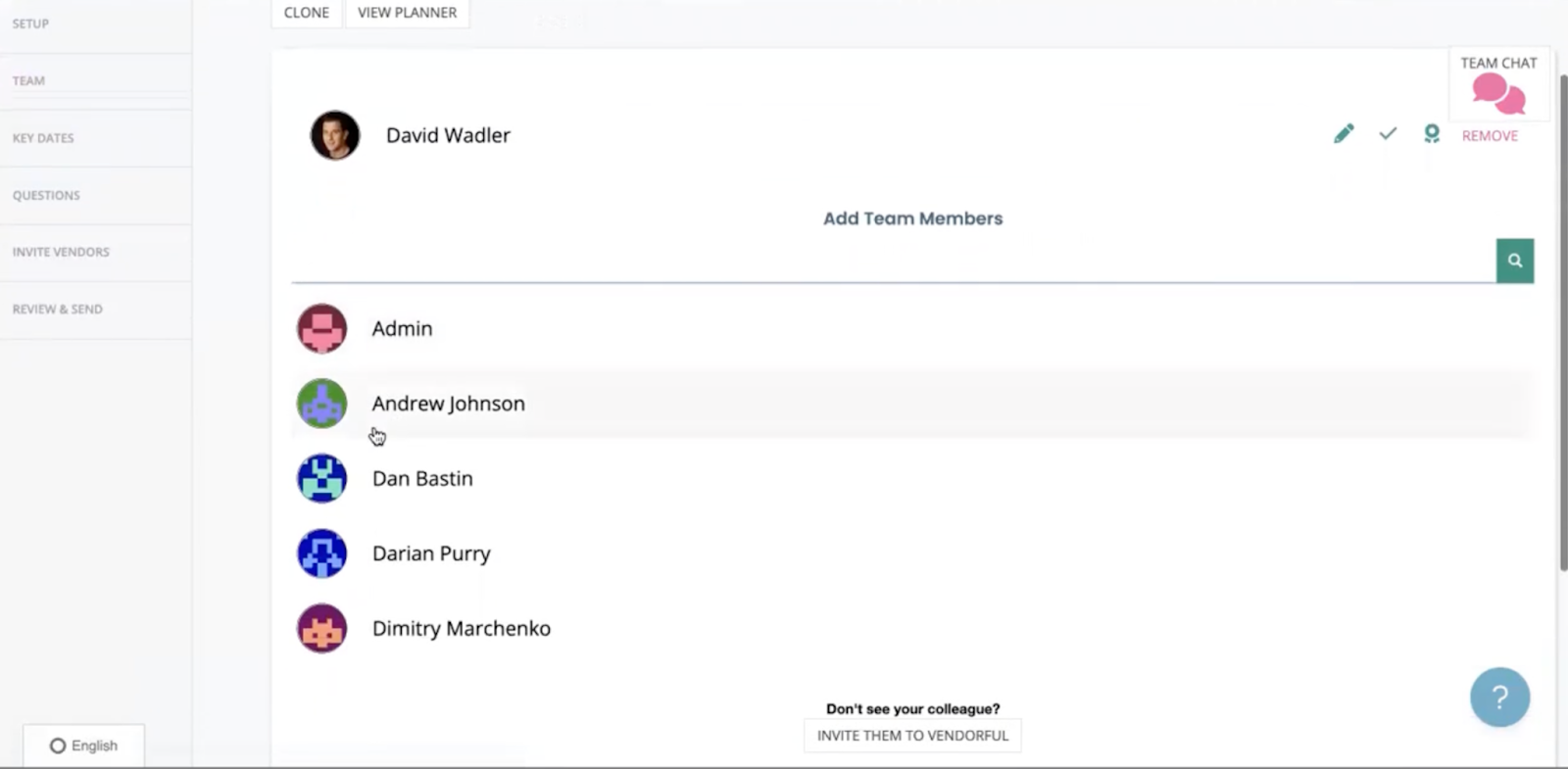
There’s also a collaborative space available for team discussions, but keep in mind, it’s viewable only internally. Next up, you can add questionnaires and choose from various question types like text, single choice, multiple selection or tables.
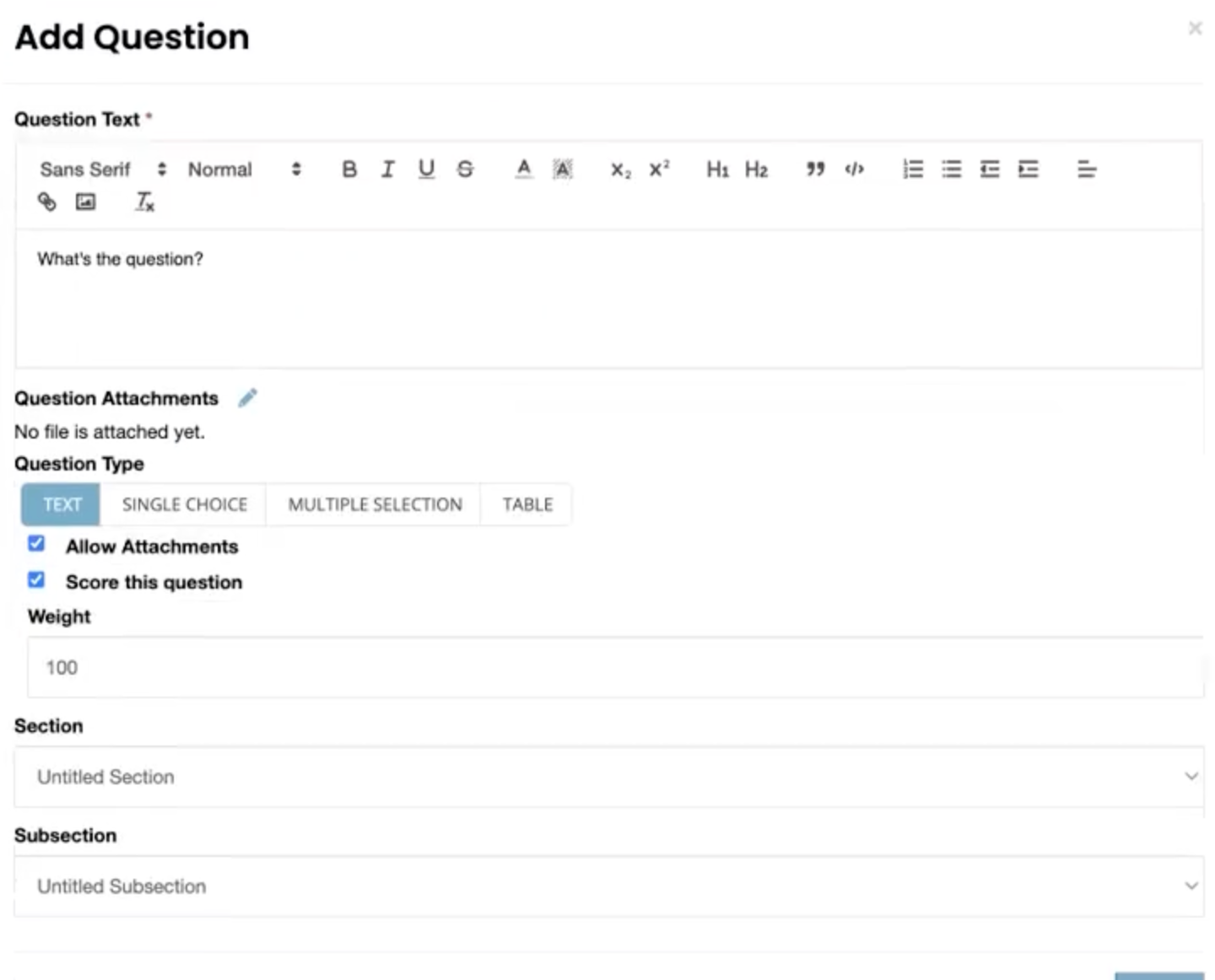
To streamline the process, you can import questions from a spreadsheet, copy and paste them, or pull from a pre-loaded template that pre-fills the questions. If you’re looking to reach out to vendors specifically, you can invite them directly or keep your RFP open to the public for broader participation.
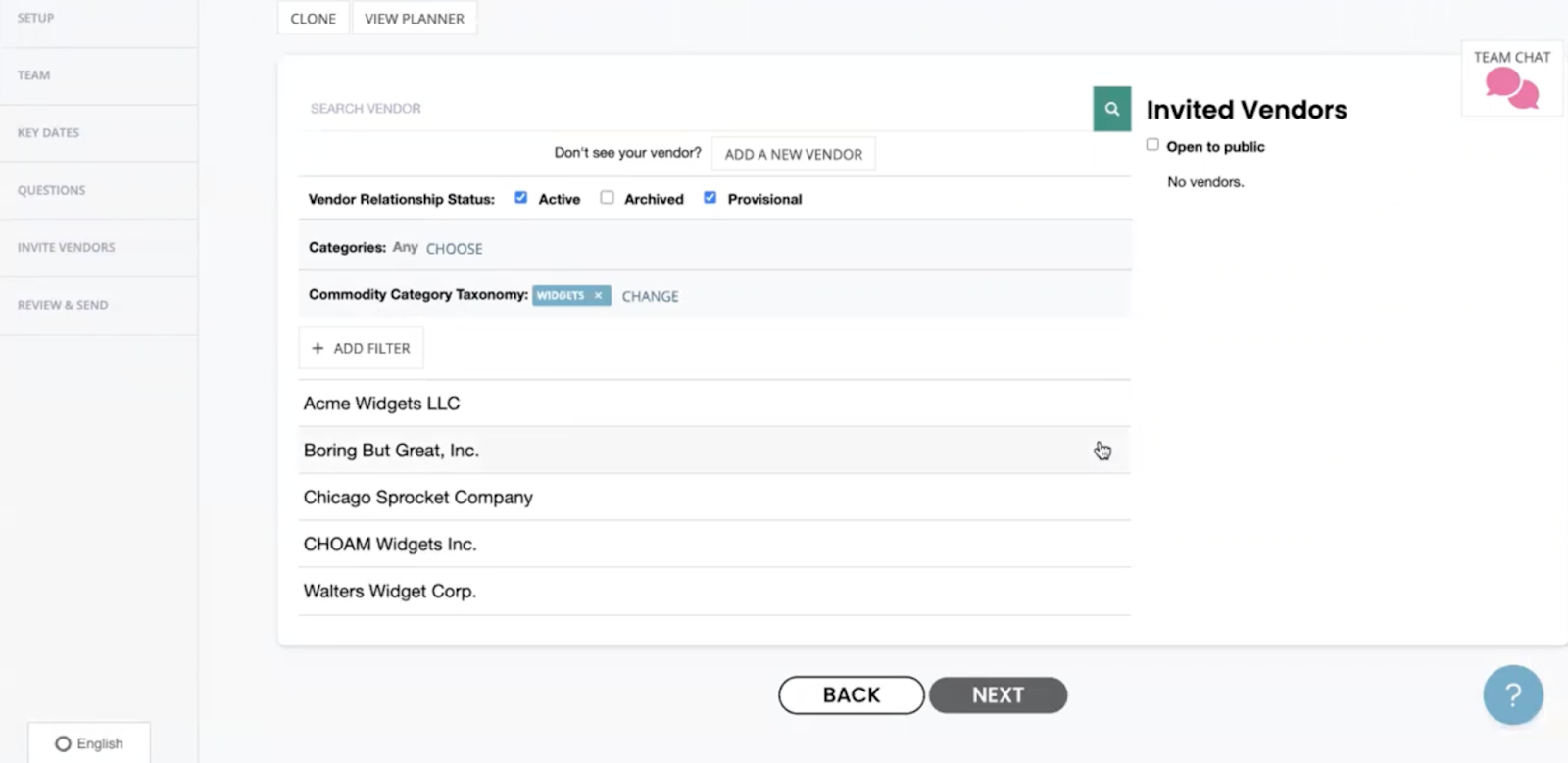
Another interesting part is that Vendorful has an AI-driven RFP response management tool. Vendors can use this to collaboratively turn what was a heavy RFP response writing process into a lightweight editing task.
Available upon request
Here’s a testimonial from one of Vendorful’s satisfied clients :
The flexibility, customer focus, and speed is unlike anything we’ve seen with other third-party service providers. Vendorful truly listens to feedback from the customer and implements suggested enhancements in near real time. - Jeff Nord, VP of Procurement, QVC
Responsive (also called Responsive.io) is an SRM (Strategic Response Management) tool that supports teams in creating responses for:
The platform includes AI-powered features for both sides of the RFP process, such as collecting all necessary information and building a compliant RFP response or creating a buyer-side RFP document.
From looking at the pricing page, Responsive RFP software caters to businesses of all sizes but their services are so robust that they’re better for large corporations and enterprises. Also, their prices aren’t displayed online; you have to contact their sales team first.
Responsive has no free trial, so I couldn’t test it firsthand. But I grabbed a screenshot of the editor from their featured video, and it looks pretty good based on what they show. To begin, you import a document into the system, which scans it and outputs a list of categorized questions.
You then ask the AI assistant to answer them using your company information. When a question has a confirmed answer, export it into a response template and build the document from there.

Unfortunately, the process for creating an RFP isn’t shared anywhere on the site nor is there a video about it.
The tools and features in the Responsive dashboard are clear and easy to decipher in a clean-cut design. There’s an option at the bottom of each answer window to save the response to the library for further RFPs. There are also toggles to mark if the answer has been reviewed yet or not.

Responsive is a versatile tool with many practical features for response management. These are the ones you should care about the most:
The pricing for Responsive is available only upon request. You'd have to contact their sales team for more information.
Enterprise RFP Software, Responsive has over 150 positive reviews on Software Advice and over 1000 on G2. The general consensus is how practical and useful the content library is and how the platform helps centralize SME responses from team members in different departments and offices.
On their site, Responsive shares several case studies about how their clients use the software. One particularly interesting case study is about how Jumio uses Responsive to create RFP responses.
Senior Director Christian Schwaiger shares in a case study,
“The Responsive response management tool has significantly improved our proposal process. Its repeatable workflows and reusable knowledge base have allowed us to streamline the process from end-to-end and increase the throughput of our RFP responses.”
Qwilr isn’t a traditional SRM/RFP intake system—it’s the modern, web-based proposal platform vendors use to turn RFP responses into stunning, on-brand, interactive proposals that win.
It’s particularly well-suited to enterprise teams that need strong governance (SSO, roles & approvals, audit trails), deep CRM integrations, and revenue workflows like quotes, signatures, and integrated payments inside the proposal; so buyers can review, sign, and pay in one smooth flow.
Unlike static PDFs, Qwilr pages are responsive and trackable. Sales and bid teams see granular analytics (views, time on section, revisit alerts) to prioritize follow-ups and tailor negotiations.
And because Qwilr plugs into Salesforce, HubSpot, Pipedrive, and Zoho (along with common martech/fintech tools), you can auto-populate content, sync deal data, update stages, and collect revenue without swivel-chairing between systems.
Key takeaway: If your RFP responses need to end as polished, interactive proposals with embedded pricing, e-sign, and payments, Qwilr is built for that last mile—at enterprise scale.

Qwilr's pricing has two tiers and the cost is per user/month. The prices are as follows:
Proposify clients are happy with the platform and leave lots of positive reviews.
“The flexibility of Qwilr sets it apart: both with the site itself and the Qwilr team. The program itself is always evolving for the better. I have realized that I can do more than proposals but also send NDAs as well as follow-up reports and case studies. It is easy to create and save templates, so I save a ton of time. As for the Qwilr team, they want to hear feedback and to be asked for more features. They want to add value. They want to be flexible to give you the experience that you need.”
Proposify is a proposal management platform for creating RFP responses using one of the many templates available. It's a popular proposal creation tool for small and medium businesses thanks to its content library and easy-to-use editor.
As a proposal software, Proposify offers a smooth proposal workflow for your sales team. As a user, you have access to a proposal template gallery and customizable content library where you can keep all approved information for your team to reference.
Here’s a video by Proposify that will help you understand how the platform can help. It will also make you chuckle a little bit.
And this is what Proposify looks like from the inside. When you get started, the platform asks you a set of questions to set up a brand guide that your proposal will build upon.
The proposal editor has several sections for customization and personalization, including shapes, videos, images, text and tables. You can create the document page by page and incorporate visual icons or colored titles with the font of your choosing.
When you’re done, you click the Generate Proposal button and follow the instructions in the dialog to share or download. This tool is simple enough but it’s definitely missing the AI capabilities that make the other RFP software on this list stand out.

As a proposal management platform, Proposify has several features to help you create RFP responses. These are the most valuable:
Since Proposify isn’t technically an RFP software like the rest of the list, it does have some limitations that make it less robust than the rest:
Proposify's pricing has three tiers and the cost is per user. The prices are as follows:
Proposify clients are happy with the platform and leave lots of positive reviews.
For example, this is one from a company CEO shared on the website homepage:
“Ridiculously useful proposal builder. It’s simple to create a new proposal from a template and customize it as necessary. Proposals look beautiful from the client’s perspective, and they are more effective than any of the other solutions I’ve tried. I have been using it for a few years now and would not consider using anything else. We can produce proposals that used to take us 2 hours in about 15 minutes. And they close at a higher rate.”
Proposable is an RFP software designed to make proposal creation fast, simple, and effective.
I checked out the Proposable software demo to see how it works, and I was impressed with how easy it makes the proposal process.
Whether you're creating, sending, or tracking proposals, it takes the hassle out of the process with smart features that save time and effort.
With its drag-and-drop builder and a library of free proposal templates, users can quickly put together professional sales documents.

I liked how custom merge tags let you personalize proposals instantly with customer and deal details—no need to manually update every document. It’s built to help you move fast without losing quality.
Team collaboration is smooth with internal comments and mentions, so you can easily loop in teammates or reassign proposals when needed. Plus, the built-in e-signature feature makes closing deals faster by guiding prospects through a simple signing process.

What stood out to me was the instant payment collection, so once a proposal is accepted, customers can pay immediately—no more chasing payments. The flexible estimate block also makes it easy to create polished, itemized quotes.
With real-time tracking, analytics, and notifications, you’ll always know when a prospect engages with your proposal, making follow-ups more effective

Proposable has been around for around seven years but hasn’t changed much since then. Since the tool is easy to use but not very robust, it’s best suited for solopreneurs and small businesses. Larger businesses might find it limited.
Here’s a behind-the-scenes look at the Proposable editor. It looks dated and old-fashioned.
There’s a small selection of content blocks to choose from and the visual layout options are minimal. Personally, even if Proposable is one of the legacy RFP tools, I’d go with one of the more recent RFP software on this list.
These are the most practical features you’ll find in Proposable:
Comparing Proposable to the other tools in this list, it does have some limitations that can keep bigger players away.
Pricing for Proposable has three tiers. In the Solo and Team plans, the price is per user and the Enterprise plan isn’t clear. All levels provide a free 14-day trial and these are their prices:
Proposable allows our company to send beautiful, professional proposals to our clients and prospects as well as better understand what happens after we hit “send.”- Jesse Thomas, Solutions Architect, Asure Software.
AutoRFP.ai is an AI-first RFP software that offers fast responses with generative AI. First, you upload or import the RFP questions into the platform. Then, the system searches your confirmed company content to write answers in your brand voice and tone.
The platform permits unlimited collaborators to edit and review responses. Users have access to AI Actions to redraft responses with prompts like shorten, simplify, improve flow and rewrite.
The software integrates with content, communication, SSO and CRM platforms to source responses. To start using AutoRFP.ai, they offer a 48-hour setup to first upload IP into the platform and integrate with the company’s work apps. Responses can then be generated either in a spreadsheet, a Word document or PDF.
AutoRFP.ai has no free trial that I could test out for you, but here’s a peek at what the AutoRFP.ai interface looks like from a video on their homepage. There are four main columns; one for the requirement, another for the AI response (it fills in automatically), a checkbox for compliance, the level of trust and the people that need to review and approve.
The dashboard looks well-structured and easy to use with everything laid out in one place. The choices on the left are buttons to see more RFPs and to review analytics. Nevertheless, it looks quite robust.
Since AutoRFP.ai is AI-first, some aspects of the software could be considered as limitations. For example:
Pricing for RFP.ai is considerably higher than others on this list and has four tiers as follows:
RFP.ai’s customers are happy with the results. In a case study published on their site, Jake Phillpot, CEO of Workforce, shared “AutoRFP.ai has taken us to the next level globally, we’re responding to double the RFPs with AI, while having time to give better responses. It’s a competitive edge.”
1Up is a relatively new AI RFP software tool that automates answers using AI and your company’s IP from several different sources.
When answering RFPs with 1Up, it pulls information from your website, Google Drive, previous RFPs, and more to give you the most complete response in less than a minute. If you already have a content library or legacy RFP tools, 1Up will migrate it all into the platform.
I asked to test out 1Up with a free trial but they answered back saying they weren’t accepting any new clients at the moment.
But here’s a screengrab of a video from 1Up’s Vimeo channel that explains how to automate an RFP workflow through collaboration. The 1Up interface has a modern gradient design that makes working pleasant.
The workflow process is straightforward and easy to follow. Aside from this view, which shows a list of answers, there’s also a main interface with list and board views of all ongoing RFP projects.
Additionally, there is a tab for assignments where you can keep track of all assigned answer reviews and approvals with deadlines. I have to say, I’m a huge fan of 1Up’s interface design—it’s not only intuitive but also exudes a positive vibe that makes using it a pleasure!
1Up is a growing company and is constantly improving. As of the date of this publication, these are the available features in the platform:
Looking at the reviews on G2, last year’s users were saying that the tool had limitations but that the team was listening. Like all other AI-based RFP software tools, it has one limitation:
The quality of the answers depends wholly on the quality of the uploaded content.
1Up RFP software pricing has three tiers covering small teams, mid-size companies and enterprises:
Kahlil Lewis, a sales engineer from FusionAuth, has great things to say about 1Up. This testimonial is featured on the company homepage. “We get lengthy RFPs with hundreds of complex questions. 1Up’s ability to automate technical knowledge has helped us accelerate this process like never before.”
Loopio is an AI-powered RFP automation software that helps create RFP responses and answer security questionnaires, sales questions, and DDQs. The platform offers collaboration systems to manage bids, schedule reviews and engage SMEs. Their Smart content library supports constant updates from your team so that AI can use it for automated answers and the auto-fill feature.
This RFP software caters to businesses of all sizes with solutions tailored to each organization’s needs and requirements. All new clients get an onboarding manager to start with Loopio and have unlimited access to their Learning Hub.
Loopio doesn’t offer a free trial so I watched several videos and reviewed user experiences to give you an opinion. For example, here’s one of Loopio’s videos that shares how their system works within a team working together on an RFP response.
At first you upload or import the RFP document into the platform. Then, the system analyzes the RFP, identifies questions and sets them up to be answered. At this point, you prompt the AI to answer the questions using the content library, which is full of approved content.
There’s a review and approval flow for everyone to look at the AI-generated questions and complete them with subject matter expertise. Updated responses keep a record of how many times they're used and team members can take a look at different versions.
These are the most practical features available in Loopio:
Here are some of the drawbacks users on G2 and Capterra share:
The pricing for Loopio is only upon request from the sales team, but there are four clear tiers:
Valarie Mammales from Alight shares in a published testimonial on Loopio’s site, “I love that I can trust Loopio as a single source of our RFPs, especially after going public. Anything I need to know, I go to Loopio first.”
Qvidian is part of the Upland software umbrella, which offers several different business tools for project, knowledge and supply chain management.
Qvidian is the RFP solution in the suite and offers a wide breadth of features for creating RFP responses, sales proposals, statements of work and answering DDQs and security questionnaires.
AI Assist, Qvidian’s AI-powered system, revises answers with generative AI via an easy-to-use conversational interface.
This software doesn’t offer a free trial either, so I reviewed their website thoroughly to see what it offers. This video from their YouTube channel gave me a good idea of how it works. The first and most important step is to fill the content library with intellectual property from which to work from. This library stays updated every time a SME reviews an answer and updates it.
The AI assist is available inside the platform as an optional tool. Users can also find answers manually to insert into a branded template.
Watch the full video to see other sections of the interface and get a better feel for the tool and everything it can do. This RFP software looks very professional and detailed, perfect for large teams that need to keep track of RFP responses without losing a beat.

Qvidian has several practical features for creating RFP responses. These are the ones I think you’ll care the most about:
In the review sites I checked out for Qvidian, users had a lot of good things to say about the platform. The reviews with cons were old and outdated, so it sounds like Qvidian is as robust and versatile as they say on their site.
Quividian doesn’t have a pricing page or tiers to compare features. You’ll have to contact them in person to learn what they offer.
A verified mid-market Qvidian user shared that,
“Qvidian is the major tool on which our RFP team relies on when answering to client questions. We use it as a knowledge database but also as a tool to create our RFP template forms. It is easy to use, fast and it completely meets our expectations and needs. Qvidian saves me a lot of time because with it I can prepare in a few minutes a brand new RFP template ready to use. In this way, I can concentrate on filling in the content with company and product specific information. Qvidian helps me improve my productivity and results. “
Sequesto is an RFP software with an integrated AI assistant called James. Its features help automate repetitive, error-prone and time-consuming tasks. When you start working on an RFP response with Sequesto, the software first analyzes the RFP to see if it’s a go/no-go and bid/no-bid according to your company's capabilities.
James then searches for content through your IP to find all the information necessary to complete the RFP response. You can then choose an RFP response template to create the final document with the AI automated answers.
Sequesto is another tool without a free trial. And since it’s relatively new, I could only get information from their website, G2, and this explainer video from Sequesto’s Vimeo channel.
In this screengrab, you can see how it integrates with Microsoft Word to help you gather up the generated and reviewed answers into a proposal document. The interface seems robust and intuitive with lots of options to create a seamless review workflow with team members.
As this is a relatively new RFP software, there are few reviews on G2 and none on Capterra. Between them, there was only one negative comment:
All pricing for Sequesto is upon request, but there are three levels: Essential, Plus, Advanced and Enterprise.
Sequesto doesn’t share any testimonials on their site or social media. But here’s one from G2 where Galyna, a small business owner, says, “Best in class response management software = Sequesto without a doubt.”
Aside from the software in this guide, there are others that can help, like PandaDoc and ClickUp. But they aren’t as versatile as Visme, for example.
Did you know Visme can help you during the RFP process, no matter what software you use?
Here are some ideas. But first, invite team members to your workspace and get ready to collaborate on your Visme-powered RFP process.
If you’re a visual learner like me, check out this video to learn how to make an RFP and RFP response that get results:
Visme makes it easy to create and send out branded RFPs with dozens of ready-to-use templates. Just pick an RFP response template design, customize it with your brand, and email it directly to vendors.
The template below, for example, is a great starting point.
If you’re racing against the clock or need a hand, you can use Visme’s AI Document Generator. Input your text prompt, choose your preferred design and let the tool generate an RFP response proposal complete with text images and other design elements.
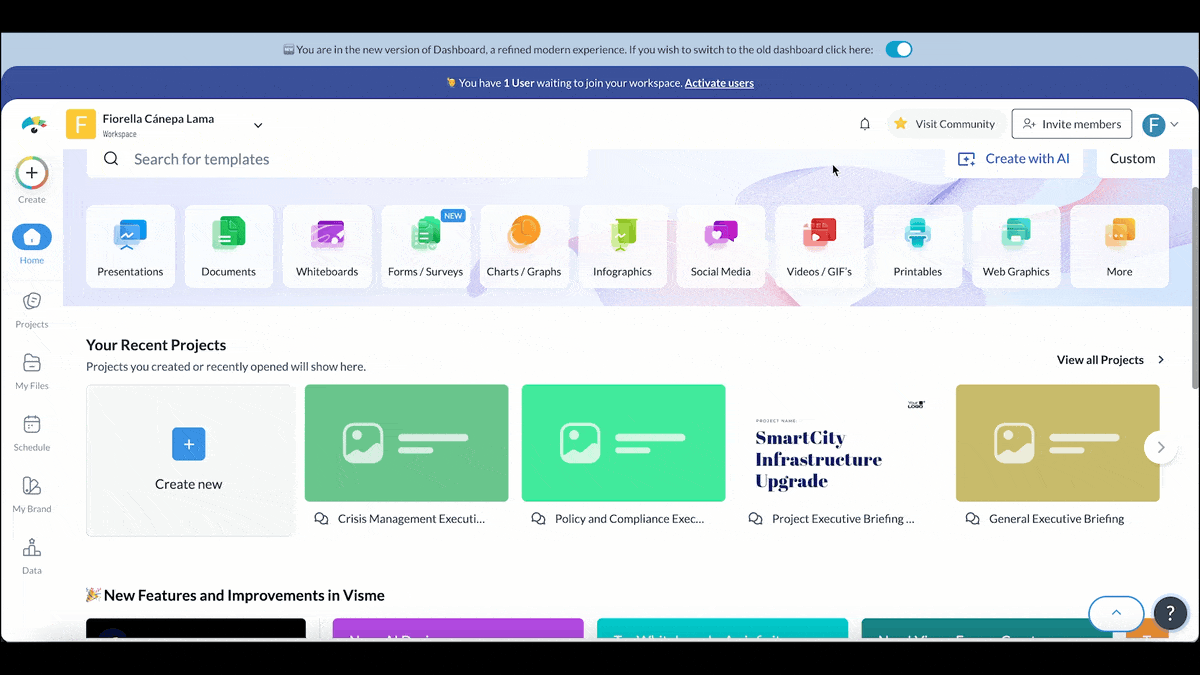
When you’re done, share and publish your RFP so that vendors can see it. Choose between a live link, digital PDF or downloadable PDF document. If you use the live link, you can track opens and views to see what vendors have taken a look at it.
Go classic and do the RFP response process manually. Then, after you write all the content, put it into a Visme template that already has all your brand assets in it.
Use Visme’s Brand Wizard to generate a handful of branded templates and turn any of the document outputs into a bid proposal template.
Then, build your RFP response from there. If you need help finessing the content in the document, use Visme’s AI Writer right inside the editor.
Go beyond a regular document and add videos, links and interactive elements like animations, hotspots and pop-ups to make your RFPs more engaging. A well-designed, easy-to-read RFP helps vendors understand your needs better and submit stronger proposals.
Watch this video to get a good idea of what you can do with interactivity on Visme. (It’s about presentations, but all the features are available for documents, too!)
Bring your team members and bid evaluators into your workspace. Assign permissions for each person to either view, comment or edit the document.
With Visme’s workflow management tool, you can assign different sections of an RFP to team members, add descriptions, set deadlines and track progress all in one place. Leave comments, share feedback and make sure everything gets done on time. No more messy email chains or lost edits.
Here are some RFP software FAQs that might answer further questions about this topic.
Several RFP software claim to be “the best” or “No.1 according to customer ratings.” So, it’s tough to confidently place one tool at the very top. Going by the ratings on the G2 platform, these are the best four RFP software, as of March 1st, 2025:
These documents exist in entirely separate contexts. RFPs occur before a business relationship is established and RMAs occur after a product has been purchased and needs to be returned.
An RFP (Request for Proposal) is a document issued by an organization seeking proposals from potential vendors or service providers. It outlines specific requirements for a project, product, or service.
An RMA (Return Merchandise Authorization) is a document or process that manages product returns between customers and vendors or manufacturers.
To find the right RFP software for your needs, you can do several actions:
There isn´t just one search engine that can be determined as the best. There are actually a few that are all good and should be used in unison. They are:
Selecting the right RFP software is a strategic decision that can dramatically improve your team's efficiency and win rates.
As we've seen throughout this review, the market offers diverse solutions ranging from AI-powered platforms like Responsive and 1Up to more traditional proposal management tools like Proposify and Proposable.
When evaluating these options for your organization, consider your specific needs: the volume and complexity of RFPs you handle, team size and collaboration requirements, integration capabilities with your existing tech stack, and of course, your budget constraints.
And remember, you can incorporate Visme into the RFP process no matter what RFP software you choose, from this list or any other.
Visme's options for RFPs are vast and can help you create visual, branded documents for both sides of the coin.
As a buyer, you can quickly create beautiful Request for Proposal documents, and as a vendor, you can easily design an RFP response to seal the deal. Open a Visme account today to optimize your organization’s RFP process immediately.
Design visual brand experiences for your business whether you are a seasoned designer or a total novice.
Try Visme for free